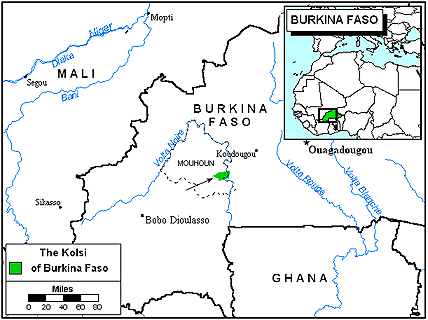The Kolsi live primarily in the Mouhoun province of central Burkina Faso. They are part of the Gur cluster of peoples, and their language, Ko, is a part of the Niger-Congo family.
Very little is known about the Kolsi in particular; thus, some assumptions have been made about their lifestyle based on groups living near them. They are thought to be similar in language and culture to the neighboring Sissala.
Burkina Faso consists of an extensive plateau slightly inclining towards the south and home to approximately 80 distinct ethnic groups. The Kolsi represent only a tiny fraction of the population. They practice subsistence farming primarily growing millet, yams, peanuts, rice and beans. Women tend household gardens, growing okra, onions, tomatoes and red peppers. They raise cattle, sheep, goats, pigs and chickens. The Kolsi also gather nuts and wild fruits, fish and hunt.
The Kolsi feel that being poor reflects on the entire kinship group as well as on the individual. Therefore, the whole household shares work duties. The elder men supervise and control the production and consumption of crops, while the younger men do the heavy farm work, such as clearing the land and tilling. Men also produce medicines and do wood carving and blacksmithing. Women may help with planting, weeding and carrying crops back home. Women prepare the food, care for the household and children, gather items from the bush and make pottery.
Kolsi villages, composed of compounds, are compact and range in size from 200 to 3,000 people. Compounds are households that include an extended family or jaw. The janwuo averages about fifty people and is divided into family households. Extended families that are related paternally live close to one another, separated only by a narrow passageway. This compact organization provides for common defense and for protection against wild animals and witches.
The Kolsi rejoice over the birth of children which ensures the continuity of the extended family. A girl is considered a woman when she gives birth to her first child. Additional children further cement the bond between husband and wife and increase the woman's status. An infant is always near its mother and is coddled and shown affection by other family members, including the father. Babies are very much loved and indulged since they can do no evil. Girls remain with their mothers until they are married. Boys, however, live with a senior male member of the janwuo from the age of six.
Although some of the Kolsi have become Muslim, about three-quarters are ethnic religionists, still following their traditional religion. They believe that their own moral behavior and rituals are necessary to maintain the order of the universe. They believe that the universe cannot exist without humans.
The Kolsi need gospel resources in their own language. Kolsi believers need further evangelism and discipleship to firmly establish the Church among them.
Ask the Lord of the harvest to send additional workers to join the few already working among the Kolsi.
Pray for the Kolsi elders and family leaders to lead their people into a vibrant relationship with the only Savior.
Pray for the Kolsi people to take up their position as ambassadors for Christ.
Scripture Prayers for the Kolsi, Ko in Burkina Faso.
| Profile Source: Joshua Project |











